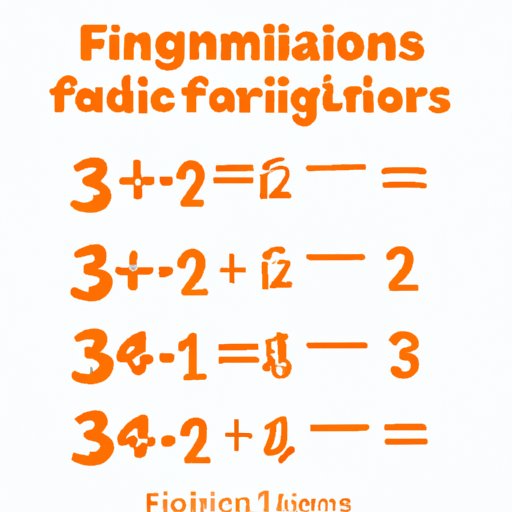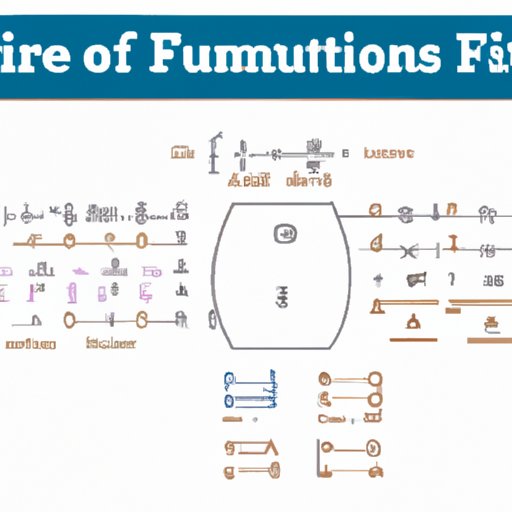
Introduction
Simplifying fractions can be a challenging concept for many students, leaving them feeling overwhelmed and confused. However, once you master the art of simplifying fractions, you’ll be able to solve complex problems with ease. In this article, we’ll break down the steps to simplify any fraction, explore more complex fractions and provide tips, tricks, and quick methods to make it easier for students to understand the process.
6 Simple Steps to Simplify Any Fraction
First, it’s important to understand what simplification means in terms of fractions. Simplifying a fraction means reducing it to its lowest possible terms. Here are six simple steps you can follow to simplify any fraction:
Step 1: Find the Greatest Common Factor
The first step towards simplifying a fraction is to find the greatest common factor (GCF) of the numerator and denominator. The GCF is the highest number that divides into both numbers without leaving a remainder. For example, the GCF of 24 and 36 is 12.
Step 2: Divide both numerator and denominator by the GCF
Once the GCF is identified, the next step is to divide both the numerator and denominator by the GCF. This will allow you to reduce the fraction and simplify it. For example, if you have the fraction 36/24, divide both numbers by 12 (the GCF):
36/12 = 3 and 24/12 = 2.
The simplified fraction is now 3/2.
Step 3: Check if the fraction can still be further simplified
After simplifying a fraction, it’s critical to check if the numerator and denominator have a common factor that can be further reduced. If you find a common factor, go back to step one and repeat the process until you can no longer simplify the fraction.
Step 4-6: Repeat steps 1-3 until the fraction can no longer be simplified
If the denominator is larger than the numerator, the fraction is proper. In the case of an improper fraction, divide the numerator by the denominator to get a proper fraction and simplify it accordingly. We repeat these steps until the fraction is fully simplified.

The Ultimate Guide to Simplifying Fractions
Now that we’ve covered the basics of simplifying fractions, let’s explore more complex scenarios that students may encounter.
Explanation of more complex fractions
More complex fractions may include mixed numbers or fractions with large denominators and numerators. Simplifying mixed numbers can be done in several ways, but the easiest method is to convert them to improper fractions. Once the mixed number is an improper fraction, you can apply the same simplification techniques discussed earlier.
When working with large numerators and denominators, it’s essential to factor these numbers before identifying the GCF. It simplifies the process and helps to avoid errors.
How to simplify fractions that have variables or exponents
When simplifying fractions with variables or exponents, we follow a similar process to the one discussed earlier. Each term will have its variables individually simplified, just like the numbers. When common variables exist, we only simplify them once. Same is with exponents and powers, we simplify them first before identifying the GCF.
Working with mixed numbers and improper fractions
Mixed numbers can also be converted to improper fractions before simplification similar to big numerators and denominators. We do this by multiplying the denominator of the whole number by the value of the numerator and adding the value obtained to the whole number numerator. This sum then becomes the new numerator of the improper fraction, and the original denominator becomes the denominator of the improper fraction. The simplification of these improper fractions proceeds in the same way as demonstrated earlier.
Mastering the Art of Simplifying Fractions: Tips and Tricks
Tips for finding the GCF quickly
The key to simplifying fractions is identifying the GCF. The faster you can find GCF, the simpler and faster it is to simplify the fraction. A few simple tips for finding the GCF include:
- Creating a list of factors for both the numerator and the denominator
- Finding the prime factors of each number and identifying the common factors
- Using a factor tree to organize the factors
Simplifying fractions with unconventional GCFs
Sometimes, GCFs are not common factors, like decimal numbers, radicals or irrationals. To simplify such fractions, we go for an alternative route to find the simplified form. Regrouping and finding equivalent forms can also simplify a fraction even if no factor can divide the numerator and denominator.
Breaking down complicated fractions into simpler ones
Sometimes, when working with complex fractions, it’s helpful to break them down into smaller pieces. The process of simplifying fractions can become much easier when breaking down a complex fraction into simpler fractions, then simplifying each of those fractions and then combining them back together into a single fraction.
Quick and Easy Methods for Simplifying Fractions
Alternative methods for simplifying fractions
Another straightforward way of simplifying some fractions is to factorize them entirely and then either cancel down or separate into multiple fractions.
Shortcut tricks for simplifying common fractions
For common fractions such as ¼, ⅓ or ⅔, there are shortcut tricks to make the simplification process easier. For example, to simplify ⅔, double both the numerator and denominator, so the fraction becomes 4/6. Then, divide both the numerator and denominator by 2 to get ⅓ as the simplified fraction.
Simplifying Fractions Made Easy: A Comprehensive Guide
Let’s review the material covered in the previous sections in this comprehensive simplified fraction guide.
Examples of fractions at different levels of complexity
Here are a few examples of fractions at varying levels of complexity to help with practicing:
- 13/10 = 1 3/10
- 216/150 = 6/5
- 9a^2/21a = 3a/7
Breaking Down Fraction Simplification: Techniques You Need to Know
Further explanation of fraction simplification techniques
Further explanation of a few fraction simplification techniques covered earlier, such as the alternative methods and shortcut tricks, went into more detail.
Common errors to avoid when simplifying fractions
Some of the common errors to avoid when simplifying fractions include dividing both the numerator and denominator by the wrong number or forgetting to check if the fraction can be further simplified in the last step.
Additional practice problems for readers to try
To improve your simplification skills, here are a couple of practice questions to try to simplify:
- 15/5 = ?
- 35/84 = ?
Conclusion
Simplifying fractions is a fundamental skill needed in mathematics. With patience and practice, anyone can master it. By following the six simple steps discussed in this article and applying the tips and tricks provided, you’ll be able to simplify even the most complex of fractions.




